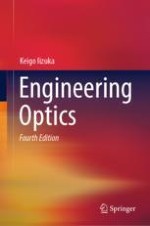2019 | OriginalPaper | Buchkapitel
11. Optical Signal Processing
verfasst von : Keigo Iizuka
Erschienen in: Engineering Optics
Aktivieren Sie unsere intelligente Suche, um passende Fachinhalte oder Patente zu finden.
Wählen Sie Textabschnitte aus um mit Künstlicher Intelligenz passenden Patente zu finden. powered by
Markieren Sie Textabschnitte, um KI-gestützt weitere passende Inhalte zu finden. powered by
